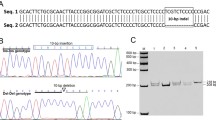Abstract
Insulin-like growth factor 1 (IGF1) is pivotal in the regulation of animal growth. Highly polymorphic CA repeat microsatellites have been identified in the IGF1 promoter region of different breeds of pigs. Previous studies showed that CA repeat microsatellites are associated with circulating IGF1 level. However, the mechanisms by which CA repeat microsatellites regulate IGF1 expression remain unclear. This study aimed to detect the association of CA repeat microsatellites with the transcriptional regulation of porcine IGF1 and the possible mechanisms. Results revealed that the number of CA repeats in porcine IGF1 promoter was 14–18, and a promoter with 14 or 15 CA repeats had a higher transcriptional activity (P < 0.01). Transcription factor hypoxia-inducible factor 1 subunit alpha (HIF1α) was confirmed to bind to the binding site upstream of CA repeat microsatellites. The microsatellites with 14 or 15 CA repeats were more sensitive to changes in the HIF1α expression level (P < 0.01). These results suggested that CA repeat microsatellites and HIF1α affected the transcriptional activity of each other in the regulation of IGF1 expression, thereby implying an interaction between them. Overall, this study provided novel evidence for elucidating the effects of CA repeat microsatellites on the transcriptional regulation of porcine IGF1.



Similar content being viewed by others
References
Adkins NL, Hagerman TA, Georgel P (2006) GAGA protein: a multi-faceted transcription factor. Biochem Cell Biol 84:559–567
Albanèse V et al (2001) Quantitative effects on gene silencing by allelic variation at a tetranucleotide microsatellite. Hum Mol Genet 10:1785
Chen HY et al (2013) Functional interaction between SNPs and microsatellite in the transcriptional regulation of insulin-like growth factor 1. Hum Mutat 34:1289–1297
David L, Peet DJ, Whelan DA, Gorman JJ, Whitelaw ML (2002) Asparagine hydroxylation of the HIF transactivation domain a hypoxic switch. Science 295:858–861
Delellis K et al (2003) IGF1 genotype, mean plasma level and breast cancer risk in the Hawaii|[sol]|Los Angeles multiethnic cohort. Br J Cancer 88:277–282
Fehringer G, Ozcelik H, Knight JA, Paterson AD, Boyd NF (2009) Association between IGF1 CA microsatellites and mammographic density, anthropometric measures, and circulating IGF-I levels in premenopausal Caucasian women. Breast Cancer Res Treat 116:413–423
Francesco EMD et al (2017) GPER mediates the angiocrine actions induced by IGF1 through the HIF-1α/VEGF pathway in the breast tumor microenvironment. Breast Cancer Res 19:129
Frayling TM et al (2002) A putative functional polymorphism in the IGF-I gene: association studies with type 2 diabetes, adult height, glucose tolerance, and fetal growth in U.K. populations. Diabetes 51:2313
Huang L (2004) The application of microsatellite DNA markers in conservation genetics of endangered animals. Chinese Biodiversity 2004–2005
Kirkpatrick BW (2010) Identification of a conserved microsatellite site in the porcine and bovine insulin-like growth factor-I gene 5′ flank. Anim Genet 23:543–548
Künzler P, Matsuo K, Schaffner W (1995) Pathological, physiological, and evolutionary aspects of short unstable DNA repeats in the human genome. Biol Chem Hoppe Seyler 376:201–224
Lemon B, Tjian R (2000) Orchestrated response: a symphony of transcription factors for gene control. Genes Dev 14:2551–2569
Li L, Cicek MS, Graham C, Witte JS (2004) No association between genetic polymorphisms in IGF-I and IGFBP-3 and prostate cancer. Cancer Epidemiol Biomark Prev 13:497–498
Martin P, Makepeace K, Hill SA, Hood DW, Moxon ER (2005) Microsatellite instability regulates transcription factor binding and gene expression. Proc Natl Acad Sci U S A 102:3800–3804
Mathews LS et al (1988) Growth enhancement of transgenic mice expressing human insulin-like growth factor I. Endocrinology 123:2827–2833
Melvin A, Rocha S (2012) Chromatin as an oxygen sensor and active player in the hypoxia response. Cell Signal 24:35–43
Nelson MD, Fitch DH (2012) Overlap extension PCR: an efficient method for transgene construction. Methods Mol Biol 772:459–470
Rechler MM, Nissley SP (1985) The nature and regulation of the receptors for insulin-like growth factors. Annu Rev Physiol 47:425–442
Rosa Reyna XFDL et al. (2010) Polymorphisms in the IGF1 gene and their effect on growth traits in Mexican beef cattle. Genet Mol Res 9:875–883
Rosen CJ et al (1998) Association between serum insulin growth factor-I (IGF-I) and a simple sequence repeat in IGF-I gene: implications for genetic studies of bone mineral density. J Clin Endocrinol Metab 83:2286–2290
Schildkraut JM et al (2005) IGF1 (CA)19 repeat and IGFBP3 -202 A/C genotypes and the risk of prostate cancer in Black and White men. Cancer Epidemiol Biomark Prev 14:403–408
Semenza GL (2001) HIF-1 and mechanisms of hypoxia sensing. Curr Opin Cell Biol 13:167–171
Sharon M et al (2014) PITX1, a specificity determinant in the HIF-1α-mediated transcriptional response to hypoxia. Cell Cycle 13:3878–3891
Shuli Y et al (2011) The local origin of the Tibetan pig and additional insights into the origin of Asian pigs. PLoS One 6:e28215
Wu D et al (2017) HIF-1α is required for disturbed flow-induced metabolic reprogramming in human and porcine vascular endothelium. Elife 6. https://doi.org/10.7554/eLife.25217
Zhang B et al (2017) Comparative transcriptomic and proteomic analyses provide insights into the key genes involved in high-altitude adaptation in the Tibetan pig. Sci Rep 7:3654
Zhao XF, Ning-Ying XU, Xiao-Xiang HU (2007) Effects of microsatellite in the regulatory region of IGF1 on growth traits in Jinhua swine. Hereditas 29:206
Zhao J et al (2017) Selection and use of microsatellite markers for individual identification and meat traceability of six swine breeds in the Chinese market. Food Sci Technol Int 24:108201321774845
Funding
This work was financially supported by the National Natural Science Foundation of China (31672514) and the Technological Development Plan of Jilin Province (20170101024JC and 20190701070GH).
Author information
Authors and Affiliations
Corresponding authors
Ethics declarations
Conflict of interest
The authors declare that they have no conflict of interest.
Additional information
Communicated by: Maciej Szydlowski
Publisher’s note
Springer Nature remains neutral with regard to jurisdictional claims in published maps and institutional affiliations.
Rights and permissions
About this article
Cite this article
Geng, H., Hao, L., Cheng, Y. et al. Interaction between CA repeat microsatellites and HIF1α regulated the transcriptional activity of porcine IGF1 promoter. J Appl Genetics 61, 105–112 (2020). https://doi.org/10.1007/s13353-019-00529-4
Received:
Revised:
Accepted:
Published:
Issue Date:
DOI: https://doi.org/10.1007/s13353-019-00529-4




